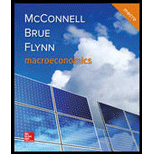
Macroeconomics
21st Edition
ISBN: 9781259915673
Author: Campbell R. McConnell, Stanley L. Brue, Sean Masaki Flynn Dr.
Publisher: McGraw-Hill Education
expand_more
expand_more
format_list_bulleted
Concept explainers
Question
Chapter 4, Problem 6DQ
To determine
The positive externalities.
Expert Solution & Answer
Want to see the full answer?
Check out a sample textbook solution
Students have asked these similar questions
Not use ai please
Not use ai please
Answer for question 1
Chapter 4 Solutions
Macroeconomics
Ch. 4.A - Prob. 1ADQCh. 4.A - Prob. 2ADQCh. 4.A - Prob. 3ADQCh. 4.A - Prob. 1ARQCh. 4.A - Prob. 2ARQCh. 4.A - Prob. 3ARQCh. 4.A - Prob. 1APCh. 4 - Prob. 1DQCh. 4 - Prob. 2DQCh. 4 - Prob. 3DQ
Ch. 4 - Prob. 4DQCh. 4 - Prob. 5DQCh. 4 - Prob. 6DQCh. 4 - Prob. 7DQCh. 4 - Prob. 8DQCh. 4 - Prob. 9DQCh. 4 - Prob. 1RQCh. 4 - Prob. 2RQCh. 4 - Prob. 3RQCh. 4 - Prob. 4RQCh. 4 - Prob. 5RQCh. 4 - Prob. 6RQCh. 4 - Use marginal cost/marginal benefit analysis to...Ch. 4 - Prob. 1PCh. 4 - Prob. 2PCh. 4 - Prob. 3PCh. 4 - Prob. 4PCh. 4 - Prob. 5PCh. 4 - Prob. 6PCh. 4 - Prob. 7P
Knowledge Booster
Learn more about
Need a deep-dive on the concept behind this application? Look no further. Learn more about this topic, economics and related others by exploring similar questions and additional content below.Similar questions
- Suppose there is a new preventative treatment for a common disease. If you take the preventative treatment, it reduces the average amount of time you spend sick by 10%. The optimal combination of Z (home goods) and H (health goods). both may increase both may increase or one may stay the same while the other increases. both may decrease H may increase; Z may not change Z may increase; H may decreasearrow_forwardIn the Bismarck system,. may arise. neither selection both adverse and risk selection ☑ adverse selection risk selectionarrow_forwardPls fill out/explain to me these notes and explanations, thanksarrow_forward
- Simple explanations plsarrow_forwardThis question examines the relationship between the Indian rupee (Rs) and the US dollar ($). We denote the exchange rate in rupees per dollar as ERS/$. Suppose the Bank of India permanently decreases its money supply by 4%. 1. First, consider the effect in the long run. Using the following equation, explain how the change in India's money supply affects the Indian price level, PIN, and the exchange rate, ERS/$: AERS/STIN ERS/$ - ·TUS = (MIN - 9IN) - (Mus - gus). MIN 2. How does the decrease in India's money supply affect the real money supply, in the long PIN run. 3. Based on your previous answer, how does the decrease in the Indian money supply affect the nominal interest rate, UN, in the long run? (hint: M = L(i)Y hold in the long run) 4. Illustrate the graphs to show how a permanent decrease in India's money supply affects India's money and FX markets in the long run. (hint: you may refer to the figures on lecture slides #5, titled "Analysis in the long run.") 5. Illustrate the…arrow_forwardPlease explain the concept/what this fill in graph, thanksarrow_forward
arrow_back_ios
SEE MORE QUESTIONS
arrow_forward_ios
Recommended textbooks for you
 Essentials of Economics (MindTap Course List)EconomicsISBN:9781337091992Author:N. Gregory MankiwPublisher:Cengage Learning
Essentials of Economics (MindTap Course List)EconomicsISBN:9781337091992Author:N. Gregory MankiwPublisher:Cengage Learning Principles of MicroeconomicsEconomicsISBN:9781305156050Author:N. Gregory MankiwPublisher:Cengage Learning
Principles of MicroeconomicsEconomicsISBN:9781305156050Author:N. Gregory MankiwPublisher:Cengage Learning Principles of Economics (MindTap Course List)EconomicsISBN:9781305585126Author:N. Gregory MankiwPublisher:Cengage Learning
Principles of Economics (MindTap Course List)EconomicsISBN:9781305585126Author:N. Gregory MankiwPublisher:Cengage Learning Principles of Microeconomics (MindTap Course List)EconomicsISBN:9781305971493Author:N. Gregory MankiwPublisher:Cengage Learning
Principles of Microeconomics (MindTap Course List)EconomicsISBN:9781305971493Author:N. Gregory MankiwPublisher:Cengage Learning Principles of Economics, 7th Edition (MindTap Cou...EconomicsISBN:9781285165875Author:N. Gregory MankiwPublisher:Cengage Learning
Principles of Economics, 7th Edition (MindTap Cou...EconomicsISBN:9781285165875Author:N. Gregory MankiwPublisher:Cengage Learning

Essentials of Economics (MindTap Course List)
Economics
ISBN:9781337091992
Author:N. Gregory Mankiw
Publisher:Cengage Learning

Principles of Microeconomics
Economics
ISBN:9781305156050
Author:N. Gregory Mankiw
Publisher:Cengage Learning

Principles of Economics (MindTap Course List)
Economics
ISBN:9781305585126
Author:N. Gregory Mankiw
Publisher:Cengage Learning

Principles of Microeconomics (MindTap Course List)
Economics
ISBN:9781305971493
Author:N. Gregory Mankiw
Publisher:Cengage Learning

Principles of Economics, 7th Edition (MindTap Cou...
Economics
ISBN:9781285165875
Author:N. Gregory Mankiw
Publisher:Cengage Learning
